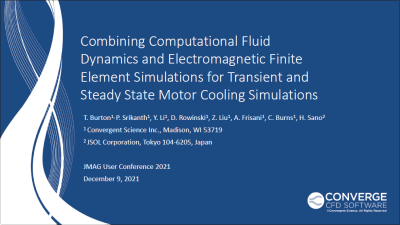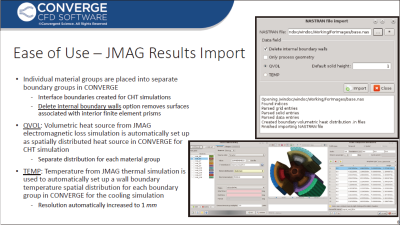Tristan Burton
Convergent Science, Inc.
概要
The worldwide vehicle fleet is undergoing a shift in technology, motivated by a recognition of the importance of reducing greenhouse gas (GHG) emissions from the global vehicle fleet. As part of this transition, battery electric vehicles (BEVs) and hybrid electric vehicles (FHEVs and PHEVs), which combine battery and high-efficiency internal combustion powertrain technology, are being advanced. Much of the current focus in BEV development centers on improving battery capacity to increase vehicle range, but the performance of the traction motors is also crucial. Many automakers employ permanent magnet motors in their vehicle designs, and this requires detailed investigation of cooling strategies to guarantee both the magnets and the windings remain in a safe operating range. To accurately assess performance, motor designers require heat transfer data as the electrical and magnetic material properties are dependent on temperature. In many situations, assumed heat transfer coefficients are applied based on analytical theory, but these values may be strongly dependent on coolant flow conditions. In this work we use JMAG to provide electromagnetic loss data and CONVERGE to perform conjugate heat transfer simulations of motors utilizing an array of cooling methodologies and compare solid temperatures to experimental data under steady state and transient conditions. Agreement is within 5-10 K for all cases.


『JMAGソフトウェア正規ユーザー(有償会員)』または『JMAG WEB MEMBER(無料会員)』でサインインが必要です。
『JMAG WEB MEMBER(無料会員)』へ登録することで、技術資料やそのほかの会員限定コンテンツを無料で閲覧できます。
登録されていない方は「新規会員登録」ボタンをクリックしてください。

